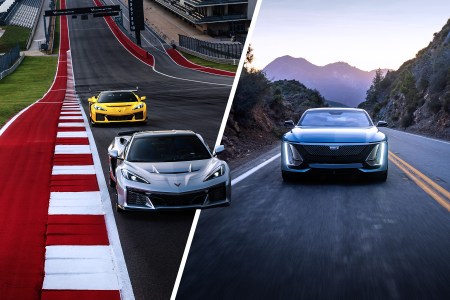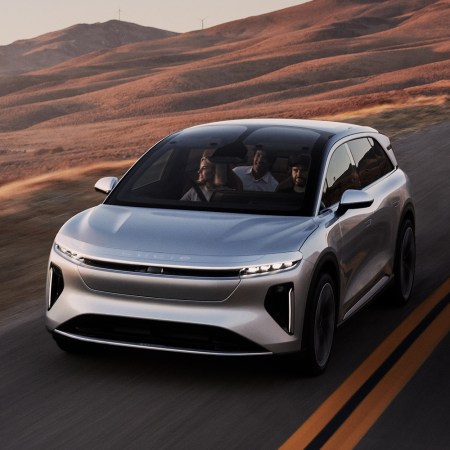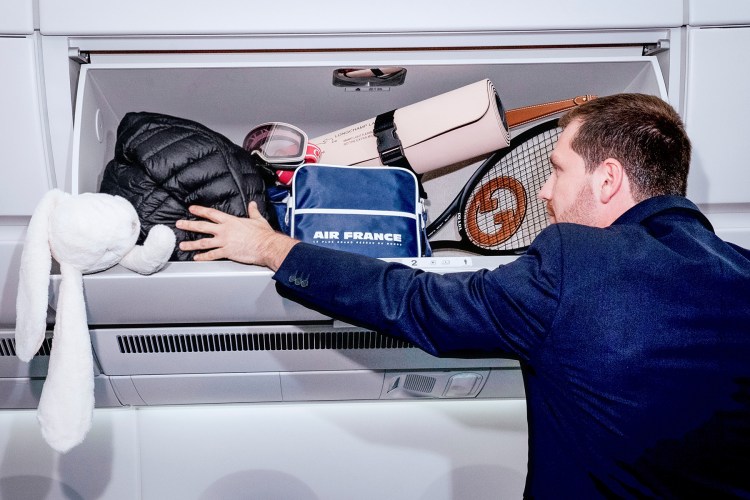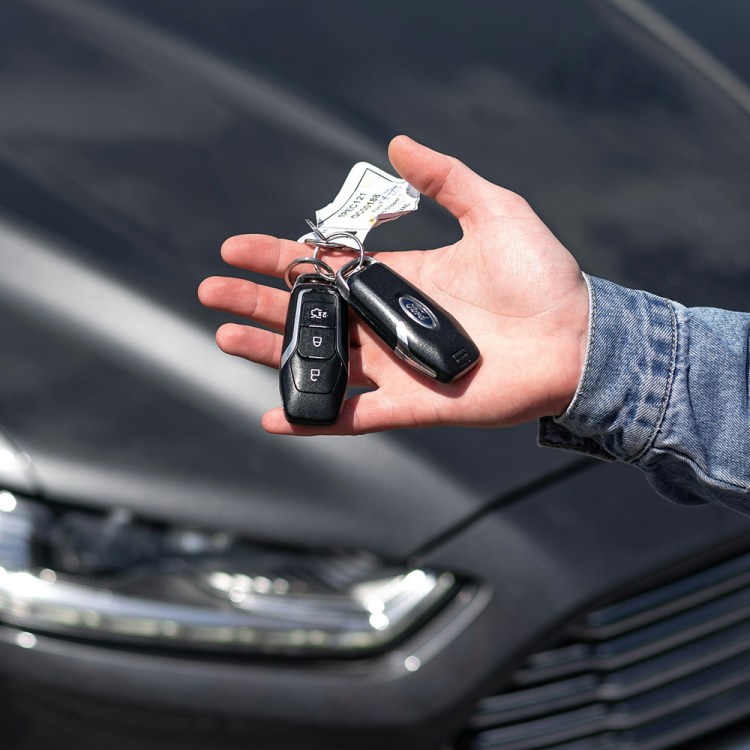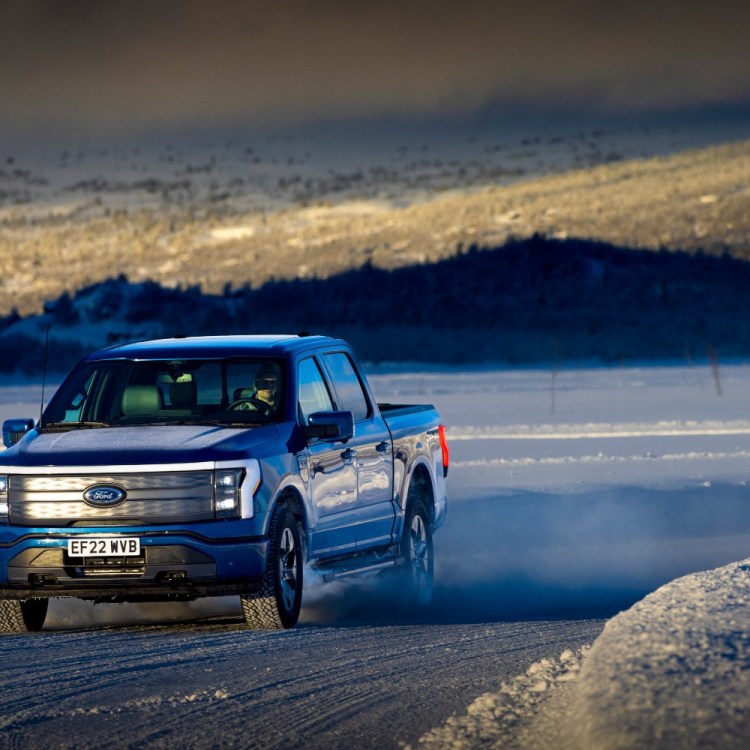The Cadillac Escalade has long stood as a shining example of SUV excess, its brand built on a quarter-century combination of overwhelming bulk and ostentatious ornamentation. For 2025, the Escalade crosses over into a new frontier on both counts with the iQ model, an all-electric edition of the luxury hauler that has more in common with same-platform predecessors like the hulking GMC Hummer EV than it does the gas-powered Escalade that’s still sold alongside it.
Battery-powered SUVs are no longer novel, but three-row models like the Escalade iQ have taken a while to catch up with their more modestly proportioned siblings. The newest Cadillac takes all notions of propriety and ejects them straight into the stratosphere, starting with its 9,000-pound curb weight (putting it in heavy-duty commercial territory for most state registrations) and continuing with its available 750-horsepower, dual-motor setup that threatens escape velocity for you and up to seven occupants should you accidentally mash the accelerator on the slightest of inclines.
It’s easy to see the electric Escalade iQ as merely the continuation of a highly successful strategy. The cost of doing this particular bit of business, however, changes once you introduce batteries into the equation — and not just in terms of dollars, but the sheer physics involved in overcoming the Cadillac’s curb weight. From this perspective, it’s obvious that while the past might be informing the present, the Escalade might not be able to stay the course if it wants to continue much further into the electrified future.

That’s No Moon
Lest you think I’m exaggerating about the Cadillac Escalade iQ’s big-boned character, sitting it alongside the gas-powered Escalade reveals 15 inches of additional length, and puts it only a couple of inches short of the extended-wheelbase version of its internal-combustion cousin.
But it’s the iQ’s 4.5-ton heft that’s the true difference-maker. You’ll have to tag in a heavy-duty pickup (or indeed, any of GM’s other Ultium-based EV trucks) to match its mass on a scale. Even the Ford F-150 Lightning is 2,500 pounds lighter than the Cadillac, to say nothing of the nearly 3,000-pound difference between the Escalade iQ and the three-row Mercedes-Benz EQS SUV or Volvo EX90 SUV (the two EVs closest in price and size to the Escalade iQ).
The Hypercar and the Bespoke EV: GM Takes on European Luxury
General Motors is throwing a one-two punch across the pond with the new Chevrolet Corvette ZR1X and Cadillac CelestiqWhy is the electric Escalade such a monster? While its plus-size proportions certainly play a role, its overall size is mostly in service of the gigantic 205-kWh battery pack stuffed into its floorboards, a unit chosen by Cadillac because it allows the iQ to advertise 460 miles of total driving range — which would make it the best of any electric SUV, though close to the Lucid Gravity.

Big Things Come in Large Packages
At its heart, then, the Cadillac Escalade iQ’s design is almost entirely a range play. For a vehicle so used to being at the top of the charts in nearly every dimension, there was no institutional shame in ballooning further to capture the distance-per-charge crown.
It’s not as if that big battery doesn’t come with other benefits. Although the vehicle’s 750 horsepower and 785 lb-ft of torque are only available when driving in Velocity Max mode (accessible via a steering wheel button), the 680 horses that pull daily duty are far from a consolation prize. The Escalade iQ is quicker than you’d expect when tooling around in a veritable battleship, and its chassis engineers have somehow managed to overcome the Cadillac’s ponderous character with an air suspension setup that glides like slippers on a hardwood floor over almost any surface, all without upsetting the calm of interior occupants.
Then there’s the condo-sized cabin lurking beneath the Escalade iQ’s striking sheet metal. This is one of the best passenger compartments the company has ever offered in terms of design and materials, and if you avoid the ultra-plush but space-sapping executive second row option that was outfitted to my tester, the Cadillac also leverages its size to provide capacious cargo room that none of its all-electric peers can match (with 8,000 pounds of towing capacity to boot).

A Bridge to Tomorrow, Rather Than a Foundation to Build On
Electrification is a moving target. If the Escalade of tomorrow must match the Escalade of yesterday not just in terms of pomp and circumstance, but also mission, today’s technology dictates building ever-bigger batteries to service increasingly unwieldy platforms. With 30% of the iQ’s weight devoted to its power pack alone, the point of diminishing returns using current technology has likely already been reached, especially when considering the vehicle’s egregious energy consumption in the range of 55 kWh per 100 miles during our week together.
On top of that, there’s the cost. With a starting price of $130,000 (cresting to $150,000 for top-tier models), the iQ isn’t outrageously positioned on the general luxury landscape, but it’s still nearly 40% more expensive than its gas equivalent, which might give pause to some loyal Cadillac customers. The presence of the $340,000 Cadillac Celestiq EV has no doubt helped recalibrate costs in the minds of the brand faithful, but the chasm remains.
That price bump is unlikely to diminish until better battery designs and energy management systems make their way into the pipeline — and indeed, it could be that today’s profits from pricey machinery like the Escalade iQ are absolutely needed for General Motors to fund the research and development that will allow for smaller, and significantly cheaper power packs.
Ideally, the end goal is to reduce the bulk of even hefty haulers like the Escalade back to their not-quite-as-eye-popping internal-combustion levels, and let the laws of physics take a break from being all bent out of shape on the daily commute. In this version of the future, no matter how opulent, comfortable or capable it might be, the current iQ is merely an intermediate step that serves to preserve Cadillac customer expectations until a more elegant, and efficient, solution presents itself.
This article appeared in an InsideHook newsletter. Sign up for free to get more on travel, wellness, style, drinking, and culture.

